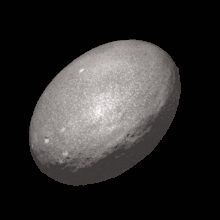Jacobi ellipsoid
A Jacobi ellipsoid is a triaxial (i.e. scalene) ellipsoid under hydrostatic equilibrium which arises when a self-gravitating, fluid body of uniform density rotates with a constant angular velocity. It is named after the German mathematician Carl Gustav Jacob Jacobi.[1]

History
Before Jacobi, the Maclaurin spheroid, which was formulated in 1742, was considered to be the only type of ellipsoid which can be in equilibrium.[2][3] Lagrange in 1811[4] considered the possibility of a tri-axial ellipsoid being in equilibrium, but concluded that the two equatorial axes of the ellipsoid must be equal, leading back to the solution of Maclaurin spheroid. But Jacobi realized that Lagrange's demonstration is a sufficiency condition, but not necessary. He remarked:[5]
"One would make a grave mistake if one supposed that the spheroids of revolution are the only admissible figures of equilibrium even under the restrictive assumption of second-degree surfaces" (...) "In fact a simple consideration shows that ellipsoids with three unequal axes can very well be figures of equilibrium; and that one can assume an ellipse of arbitrary shape for the equatorial section and determine the third axis (which is also the least of the three axes) and the angular velocity of rotation such that the ellipsoid is a figure of equilibrium."
Jacobi formula

The broken lines are for the Maclaurin spheroid in the range where it has dynamic but not secular stability – it will relax into the Jacobi ellipsoid provided it can dissipate energy by virtue of a viscous constituent fluid.
For an ellipsoid with equatorial semi-principal axes and polar semi-principal axis , the angular velocity about is given by
where is the density and is the gravitational constant, subject to the condition
For fixed values of and , the above condition has solution for such that
The integrals can be expressed in terms of incomplete elliptic integrals.[6] In terms of the Carlson symmetric form elliptic integral , the formula for the angular velocity becomes
and the condition on the relative size of the semi-principal axes is
The angular momentum of the Jacobi ellipsoid is given by
where is the mass of the ellipsoid and is the mean radius, the radius of a sphere of the same volume as the ellipsoid.
Relationship with Dedekind ellipsoid
The Jacobi and Dedekind ellipsoids are both equilibrium figures for a body of rotating homogeneous self-gravitating fluid. However, while the Jacobi ellipsoid spins bodily, with no internal flow of the fluid in the rotating frame, the Dedekind ellipsoid maintains a fixed orientation, with the constituent fluid circulating within it. This is a direct consequence of Dedekind's theorem.
For any given Jacobi ellipsoid, there exists a Dedekind ellipsoid with the same semi-principal axes and same mass and with a flow velocity field of[7]
where are Cartesian coordinates on axes aligned respectively with the axes of the ellipsoid. Here is the vorticity, which is uniform throughout the spheroid (). The angular velocity of the Jacobi ellipsoid and vorticity of the corresponding Dedekind ellipsoid are related by[7]
That is, each particle of the fluid of the Dedekind ellipsoid describes a similar elliptical circuit in the same period in which the Jacobi spheroid performs one rotation.
In the special case of , the Jacobi and Dedekind ellipsoids (and the Maclaurin spheroid) become one and the same; bodily rotation and circular flow amount to the same thing. In this case , as is always true for a rigidly rotating body.
In the general case, the Jacobi and Dedekind ellipsoids have the same energy,[8] but the angular momentum of the Jacobi spheroid is the greater by a factor of[8]
See also
- Maclaurin spheroid
- Riemann ellipsoid
- Roche ellipsoid
- Dirichlet's ellipsoidal problem
- Spheroid
- Ellipsoid
References
- Jacobi, C. G. (1834). "Ueber die Figur des Gleichgewichts". Annalen der Physik (in German). 109 (8–16): 229–233. Bibcode:1834AnP...109..229J. doi:10.1002/andp.18341090808.
- Chandrasekhar, S. (1969). Ellipsoidal figures of equilibrium. Vol. 10. New Haven: Yale University Press. p. 253.
- Chandrasekhar, S. (1967). "Ellipsoidal figures of equilibrium—an historical account". Communications on Pure and Applied Mathematics. 20 (2): 251–265. doi:10.1002/cpa.3160200203.
- Lagrange, J. L. (1811). Mécanique Analytique sect. IV 2 vol.
- Dirichlet, G. L. (1856). "Gedächtnisrede auf Carl Gustav Jacob Jacobi". Journal für die reine und angewandte Mathematik (in German). 52: 193–217.
- Darwin, G. H. (1886). "On Jacobi's figure of equilibrium for a rotating mass of fluid". Proceedings of the Royal Society of London. 41 (246–250): 319–336. Bibcode:1886RSPS...41..319D. doi:10.1098/rspl.1886.0099. S2CID 121948418.
- Chandrasekhar, Subrahmanyan (1965). "The Equilibrium and the Stability of the Dedekind Ellipsoids". Astrophysical Journal. 141: 1043–1055. Bibcode:1965ApJ...141.1043C. doi:10.1086/148195.
- Bardeen, James M. (1973). "Rapidly Rotating Stars, Disks, and Black Holes". In DeWitt, C.; DeWitt, Bryce Seligman (eds.). Black Holes. Houches Lecture Series. CRC Press. pp. 267–268. ISBN 9780677156101.